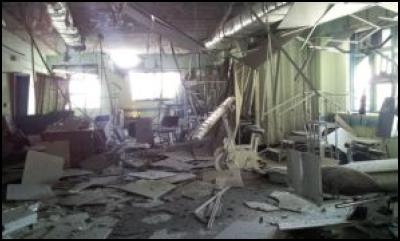WHO Appeals for US$ 8.7 Million to Rejuvenate Gaza’s Health
WHO Appeals for US$ 8.7 Million to Rejuvenate, Improve Gaza’s Health System

Almost half of the hospitals in Gaza were damaged or destroyed during the conflict, including Al Wafa Hospital
The July–August hostilities that reduced much of the Gaza strip to rubble have faded from the headlines – but recovery work is just beginning, and the World Health Organization (WHO) says the territory’s shattered health system needs extensive reconstruction and resources.
WHO is appealing for US$ 8.7 million as part of an overall US$ 45.1 million effort to repair and enhance Gaza’s health care system.
“Gaza’s health system has been weakened and overstretched due to years of occupation, blockade, and conflict,” says Dr Gerald Rockenschaub, head of WHO’s office for the occupied Palestinian territories. “We need not simply to restore Gaza’s hospitals, clinics and other health facilities to previous levels, but to strengthen them significantly.”
Among WHO’s plans are:
expanding the ranks of health workers, upgrading their training, and securing for them sufficient and regular pay;
overcoming gaps in services, especially for the elderly, persons with disabilities, and persons with mental health problems;
strengthening detection and treatment of noncommunicable diseases, which are Gaza’s leading causes of death and include such ailments as high blood pressure, cardiovascular illnesses, cancers, and diabetes; and
augmenting the information systems that underpin effective and efficient health care.
Damage inflicted on Gaza’s health system during the 51-day conflict, which ended in August 2014, was massive. Seven health facilities were destroyed, including Gaza’s only specialized rehabilitation hospital. Preliminary surveys show that 67 facilities were damaged to varying degrees. A glut of trauma patients during the crisis and a flood of others afterward - once it was possible for them to leave shelter and seek care for new or pre-existing conditions – have used up stocks of essential medicines and have exhausted health staff.
The conflict killed 2145 and injured 11 231, of whom 10% are likely to have long-term or permanent injuries.
In fact the long-term toll is only gradually becoming apparent. It is estimated, for example, that up to 20% of Gaza’s population – some 360 000 people – now could need treatment for mental-health disorders in the wake of the hostilities.There was a shortage of mental health services before the conflict.WHO is now implementing a three-year project to strengthen such care, including by expanding qualified staff and extending counselling services to more of Gaza’s primary health centres – and eventually to all of them – and by establishing facilities for treating severe and long-term conditions.
Beyond those injured by violence, the assessment showed that during and after the conflict people with chronic health conditions such as cardiovascular disease, cancer and diabetes suffered from inaccessibility of services, shortage of drugs, and an increase in the demand for referrals outside of Gaza for patients who cannot receive adequate services in the Strip.
Meanwhile, overall shortages of health staff have been exacerbated by the fighting, during which 23 health care workers were killed and 83 injured.
WHO is also calling for a review of emergency preparedness plans, the development of comprehensive contingency plans, and the prepositioning of essential medical supplies so that any future crisis in Gaza can be met with an effective and well-coordinated response.
ENDS


 East West Center: NZ Deputy Prime Minister Recounts Longstanding US-NZ Relationship In The Pacific
East West Center: NZ Deputy Prime Minister Recounts Longstanding US-NZ Relationship In The Pacific Global Jews for Palestine: Jewish Organisations' Passover Statement, After 40 Days Of Starvation
Global Jews for Palestine: Jewish Organisations' Passover Statement, After 40 Days Of Starvation APEC: Stronger Immunization Policies Needed As Vaccine Confidence Falls
APEC: Stronger Immunization Policies Needed As Vaccine Confidence Falls 350.org: Indigenous Groups From The Pacific, Brazil & Canada Hand Demands To COP30 Presidency To End Fossil Fuels
350.org: Indigenous Groups From The Pacific, Brazil & Canada Hand Demands To COP30 Presidency To End Fossil Fuels Conservation International: Conservation International Expedition Reveals Ecosystem Recovery In Tokelau
Conservation International: Conservation International Expedition Reveals Ecosystem Recovery In Tokelau UN Special Procedures - Human Rights: UN Expert Urges States To Finance Inclusive And Sustainable Development, Not A War Economy
UN Special Procedures - Human Rights: UN Expert Urges States To Finance Inclusive And Sustainable Development, Not A War Economy